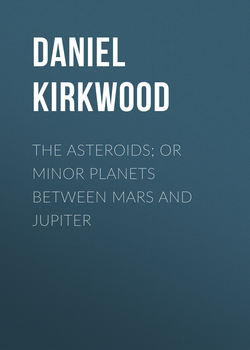The Asteroids; Or Minor Planets Between Mars and Jupiter

Реклама. ООО «ЛитРес», ИНН: 7719571260.
Оглавление
Daniel Kirkwood. The Asteroids; Or Minor Planets Between Mars and Jupiter
PREFACE
PART I. THE ASTEROIDS, OR MINOR PLANETS BETWEEN MARS AND JUPITER
1. Introductory
2. Discovery of the First Asteroids
TABLE I. The Asteroids in the Order of their Discovery
3. Remarks on Table I
4. Mode of Discovery
5. Magnitudes of the Asteroids
6. The Orbits of the Asteroids
TABLE II. Elements of the Asteroids
PART II. DISCUSSION OF THE FACTS IN TABLE II
1. Extent of the Zone
2. The Small Mass of the Asteroids
3. The Limits of Perihelion Distance
4. Was the Asteroid Zone originally Stable?—Distribution of the Members in Space
5. Relations between certain Adjacent Orbits
6. The Eccentricities
7. The Inclinations
8. Longitudes of the Perihelia
9. Distribution of the Ascending Nodes
10. The Periods
11. Origin of the Asteroids
12. Variability of Certain Asteroids
13. The Average Asteroid Orbit
14. The Relation of Short-Period Comets to the Zone of Asteroids
APPENDIX
NOTE A
NOTE B
Отрывок из книги
The first observer who watched the skies with any degree of care could not fail to notice that while the greater number of stars maintained the same relative places, a few from night to night were ever changing their positions. The planetary character of Mercury, Venus, Mars, Jupiter, and Saturn was thus known before the dawn of history. The names, however, of those who first distinguished them as "wanderers" are hopelessly lost. Venus, the morning and evening star, was long regarded as two distinct bodies. The discovery that the change of aspect was due to a single planet's change of position is ascribed to Pythagoras.
At the beginning of the seventeenth century but six primary planets and one satellite were known as members of the solar system. Very few, even of the learned, had then accepted the theory of Copernicus; in fact, before the invention of the telescope the evidence in its favor was not absolutely conclusive. On the 7th of January, 1610, Galileo first saw the satellites of Jupiter. The bearing of this discovery on the theory of the universe was sufficiently obvious. Such was the prejudice, however, against the Copernican system that some of its opponents denied even the reality of Galileo's discovery. "Those satellites," said a Tuscan astronomer, "are invisible to the naked eye, and therefore can exercise no influence on the earth, and therefore would be useless, and therefore do not exist. Besides, the Jews and other ancient nations, as well as modern Europeans, have adopted the division of the week into seven days, and have named them from the seven planets; now, if we increase the number of planets this whole system falls to the ground."
.....
For the convenience of astronomers, Professor Harding, of Lilienthal, undertook the construction of charts of all the small stars near the orbits of Ceres and Pallas. On the evening of September 1, 1804, while engaged in observations for this purpose, he noticed a star of the eighth magnitude not mentioned in the great catalogue of Lalande. This proved to be a third member of the group of asteroids. The discovery was first announced to Dr. Olbers, who observed the planet at Bremen on the evening of September 7.
Before Ceres had been generally adopted by astronomers as the name of the first asteroid, Laplace had expressed a preference for Juno. This, however, the discoverer was unwilling to accept. Mr. Harding, like Laplace, deeming it appropriate to place Juno near Jupiter, selected the name for the third minor planet, which is accordingly known by this designation.
.....